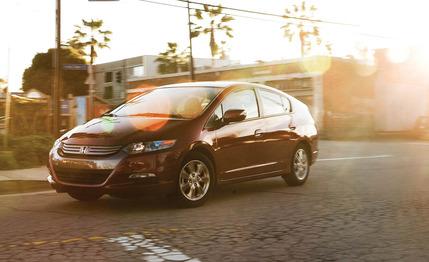 Long-Term Road Test Wrap-Up
Long-Term Road Test Wrap-Up

It’s one thing to arrive late to a party. It is quite another to arrive so late that all the other guests have already moved on to a better, slightly more fashionable party. Such is the case with the Insight. Honda started the affair with the original Insight in December 1999, but Toyota’s Prius, which made its U.S. debut early the next year, proved to be far more popular. After seven model years, Honda sulked away. For 2010, the company came back to see a hybrid shindig now fully populated by almost every automaker sporting the latest in dual-propulsion technology.
Although the second-generation Insight adds two doors, three seats, and an extra cylinder, power—as in other Honda hybrids—still comes from a gasoline engine paired with an inline electric motor that provides assist at low speeds and converts kinetic energy to electricity when coasting or braking. With the motor permanently linked to the engine, the Insight lacks an engine-off full-electric mode, which makes it appear dated compared with other hybrids that can cruise with the engine resting.
Honda’s angle is affordability. With the 2010 LX model commanding a modest $20,510, the Insight was positioned as the least-expensive hybrid on the market, undercutting the Prius by $1650. The Toyota, however, came with EPA figures of 51 mpg city and 48 highway. The Insight’s smaller price came with correspondingly smaller EPA fuel-economy numbers. Our Insight rates 40 mpg city and 43 highway, the same as the Civic hybrid’s 2011 numbers (revised from a previous 45 mpg highway). The Civic starts at $4000 more than the LX Insight but also comes with more power and more interior space, and the new-for-2012 Civic hybrid hits 44 mpg on both cycles.
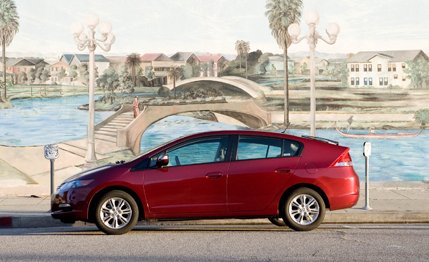
The EPA mileage figures are a bit of a head scratcher, but the Insight managed an observed 38 mpg to the Prius’s 42 in a July 2009 comparison test, narrowing the gap between the two in real-world driving. Plus, our early impressions of the Insight pegged it as the driver’s choice. We decided to investigate further, and West Coast technical editor Aaron Robinson took delivery of a Tango Red Pearl Insight EX, base price $22,010. Adding to the pretense of a driver’s hybrid, the EX model comes with paddle shifters that contrive manual “gears” in the continuously variable transmission. To that we added navigation ($1800), satellite radio ($310), a cargo cover ($195), and carpeted floor mats ($104) for a total price of $24,419.
Living with the Insight revealed a number of peculiarities, such as its stop-start system. In theory, the system shuts down the engine at low speeds and when the car is immobile. But on a hot day, the engine would fire up unpredictably to give some much-needed juice to the air conditioning. The engine also runs when the transmission is in park; this is so an unknowing driver doesn’t exit the car when all’s quiet, thinking the ignition is off. For all the trouble of a stop-start system, our Insight spent more time idling than we expected.
The Insight was also highly susceptible to crosswinds, inspiring logbook descriptions that, depending on the weather conditions, ranged from “abject wobbler” to “I can’t believe the upper-arm workout I get just to stay in my lane.” One potential culprit was a bad alignment. Just past 20,000 miles on the odometer, we noticed abnormal wear on the front tires. A local dealer performed an alignment ($95) at the next routine service. The crosswind problem persisted, but by then the Insight rode on Bridgestone Blizzak WS60 ice and snow tires ($420). We couldn’t rule out the winter tires as a contributing factor since they are not known for dry-road prowess. With the arrival of spring, we switched back to the factory all-season tires, replacing the abnormally worn fronts at a cost of $421 (including mounting and balancing). This made no difference, and the Insight still lacked directional stability at highway speeds.
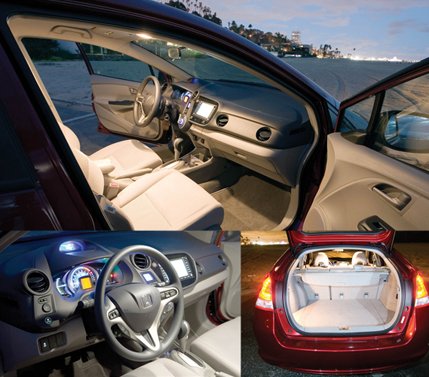
Technical director Don Sherman advanced the theory that the Insight’s slippery profile produces lift at high speed, thereby decreasing stability. Whether or not that’s the reason for its wandering ways, the Insight’s shape is the source of our other main complaint: The all-glass fastback/Kamm tail is separated by a crossbeam that obscures rearward vision.

Fortunately, we spend most of our time behind the wheel looking forward, and the Insight has an expansive view through its windshield. Ergonomics and the front seats are also top-notch. The one exception is the dated navigation system, which is plagued with tiny buttons.
Our Insight visited the dealership a mere three times during its 40,000-mile tour, and each stop was for scheduled maintenance. Total service costs came to a low $357. At 26,640 miles, we replaced the weatherstripping on the passenger-side roof (which repeatedly popped out of place under the duress of automatic carwashes) and the trim on the rear wiper, which was falling apart. The cost of both pieces came to $41, and they were installed in our garage by our capable road warriors.
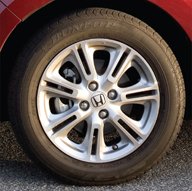
Our average fuel economy of 39 mpg is a testament to the Insight’s fuel-sipping prowess. Moreover, 40-plus mpg figures were common on highway trips. But some of that frugality no doubt came from the modest 88-hp, 1.3-liter four, which has few other positive traits. Even with the additional output of the electric motor (13 horsepower, 58 pound-feet), the Insight is slow. Zero-to-60 acceleration was a lazy 10.9 seconds when new and slowed to 12.0 seconds at the end of our test. We made sure the battery was fully charged for both track sessions, so we cannot explain why the car became slower with age. Flooring the gas pedal, and putting up with the accompanying engine drone, was simply part of the Insight experience.
More than the lethargic powertrain, and more than the erratic crosswind handling, the Insight fell in our consideration as the miles wore on. Why? Its general and off-putting lack of refinement. The sporty-feeling ride, it turns out, is actually only sporty for a hybrid. Compared with other cars, even Honda’s own Fit, the ride is rigid. Worse is the integration of the hybrid system. Pulling away from a stop, the Insight’s engine fires up with a shudder, in contrast to the smooth light-off of the Ford Fusion hybrid. Brake-pedal modulation is generally bad at all velocities but gets worse at parking-lot speeds when the re-gen abruptly cuts out just before the car stops.
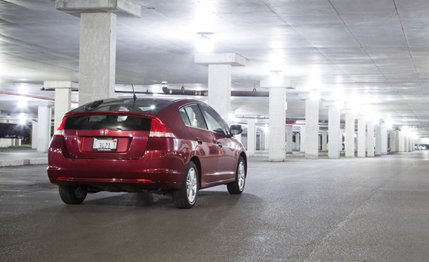
In the moons since this Insight’s introduction, the hybrid world has advanced significantly, and newer offerings provide seamless operation and better driving dynamics. Ironically, most of the new hybrids use powertrain configurations similar to Honda’s, with their electric motors sandwiched between their engines and transmissions. But in the best hybrid systems, an extra clutch allows for smooth power delivery and electric-only operation. Our Insight gave us 40,000 miles of mostly trouble-free, high-mpg driving, and it remains the most affordable hybrid available, a bragging right no automaker seems eager to challenge. But the Insight is also the most basic of high-tech hybrid transportation, and it left us wanting.